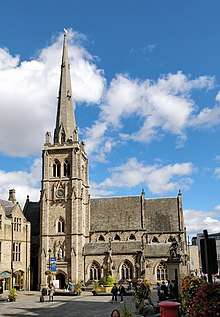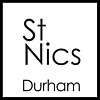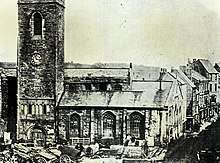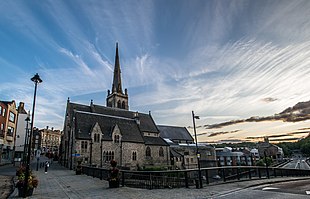St Nicholas Church, Durham
St Nicholas Church, commonly known as St Nic's, is a Church of England place of worship located on Durham marketplace and is the city's civic church. The church stands in the open evangelical tradition of the Church of England.
| St Nicholas Church, Durham | |
|---|---|
| St Nic's | |
 The church viewed from the marketplace | |
 St Nicholas Church, Durham | |
| 54°46′39″N 1°34′31″W | |
| Location | Durham, County Durham |
| Country | England |
| Denomination | Church of England |
| Churchmanship | Open Evangelical |
| Website | www |
| History | |
| Status | Civic church |
| Dedication | Saint Nicholas |
| Architecture | |
| Functional status | Active |
| Heritage designation | Grade II |
| Architect(s) | James Pigott Pritchett junior |
| Completed | 1858 |
| Specifications | |
| Bells | 6 (1687) |
| Administration | |
| Parish | St Nicholas Durham |
| Deanery | Deanery of Durham |
| Archdeaconry | Archdeaconry of Durham |
| Diocese | Diocese of Durham |
| Province | Province of York |
| Clergy | |
| Vicar(s) | The Revd Arun Arora |
| Curate(s) | Claire Elwood Maeve Sherlock |
| NSM(s) | The Revd Prof Peter Johnson The Revd Colin Patterson The Revd David V. Day |
| Laity | |
| Reader(s) | Jamie Harrison Andrew Trigger |
 | |
History

Old St Nicholas' Church
The original St Nicholas' Church is thought to have been founded in the early 12th century by Ranulf Flambard, Prince Bishop of Durham. He cleared Palace Green, between the cathedral and his castle, and established the current marketplace below the castle, with the church of St Nicholas, patron saint of merchants, beside it.[1][2]
This church had a buttressed nave and chancel, and a square tower with battlements. Its north wall formed part of the city walls, and abutted the ancient Clayport Gate on one side until the gate's demolition in 1791.[1] A graveyard lay between the church and the marketplace, and another behind the church.[1]
The building was extensively modified over the centuries, including shortening of the east end to allow widening of the road, and in the 19th century a market piazza was built against its south wall.[1] It was described in 1803 as "very ruinous".[1]
1858 rebuilding
In 1854, a competition was held to secure an architect to renovate the church, which was won by 24-year-old Darlington-based architect James Pigott Pritchett junior.[1][3] However, when the market piazza was demolished, it was found that the church was beyond repair, and Pritchett was engaged instead to design and build a new church. The incumbent, George Townshend Fox, gave an initial donation of £1000 (equivalent to £95,000 in 2019) towards the cost of rebuilding.[3]
The old church was demolished in June 1857.[1] Almost all that remains from is its font, dating from 1700, and its five bells, dating from 1687 and therefore the oldest ring of bells in the diocese. Though the bells were not rung from the 1970s onwards due to fears for the safety of the tower, ringing resumed in 2000 and the 17th-century bells, along with a sixth added in 1889, are now rung frequently.
Pritchett's new church, in the decorated gothic style, was estimated to cost £3600 (equivalent to £365,000 in 2019) and was opened with great ceremony in December 1858.[1] The building was described by the Illustrated London News at the time as "the most beautiful specimen of church architecture in the north of England", and was considered by Nikolaus Pevsner to be one of Pritchett's best.[4] It was the first church in Durham to have a spire; which had not been part of Pritchett's original plan, but was added at the behest of Fox, who paid the £400 cost himself.[1] It is a Grade II listed building.[5]
Reordering and later
George Carey, later Archbishop of Canterbury, was vicar of St Nicholas from 1975 to 1982. During that time he led a project, supervised by ecclesiastical architect Ronald Sims, in which the pews and the majority of the Victorian interior features of the church were removed to allow the church to be used more flexibly for worship and community activities.[1] Carey's book The Church in the Marketplace describes the process and its impact on the life of the parish.[6]
Parish and population

The parish is small (covering only the area around the Market Place, Claypath and The Sands) and is bounded by the parishes of Durham's three other ancient city churches - St Giles', St Oswald's and St Margaret's. Historically the parish was densely populated; however, slum clearance in the 1920s (as well as commercial development of previously residential areas) greatly reduced the population of the parish, and though more recent building has increased this a little, the church draws the majority of its congregation from outside its own parish. It has a large student population, and is classified by the Diocese of Durham as its own locality, meaning that its mission is recognised as distinctly different from those of other city centre churches. The church has a long tradition of evangelicalism, and its patronage has been held by the Church Pastoral Aid Society since the mid-19th century.
Outreach
One notable feature of the reordered church is the Gateway World Shop, which occupies the south-east corner of the church, having its own outside entrance, and sells Fair trade goods. The shop reflects the church's long involvement with the fair trade movement; Richard Adams, founder of Traidcraft, was a member of the church.
St Nics has a long history of supporting overseas mission. The first bishop of Uganda, Alfred Tucker, left his curacy at St Nics to bring Christianity to Uganda. This support is currently expressed by the church's financial support of the Church Mission Society, South American Missionary Society, the Bible Society, Spanish Outreach Ministries and the diocese of Lesotho.
Notable clergy
- Arun Arora became vicar in 2017, having previously been Director of Communications for the Church of England since 2012.
- Pete Broadbent, later Bishop of Willesden, served his curacy here in the late 1970s.
- George Carey, later Archbishop of Canterbury, was vicar of St Nicholas from 1975 to 1982.
- David V. Day, former Principal of St John's College, Durham, was a non-stipendiary minister from 1999 to 2007, and remains part of the ministry team as of 2019.
- Alistair Magowan, later Bishop of Ludlow, was curate here 1984-9.
- George Marchant, was vicar of St Nicholas from 1954 to 1974.
- Maeve Sherlock, Baroness Sherlock, became curate here in 2018.
- Alfred Tucker, later Bishop of Eastern Equatorial Africa, served his curacy here in the 1880s.
- John Wenham, Biblical scholar, was vicar 1948-1953.
- Frank White, later Bishop of Brixworth, served his curacy here in the 1980s.
References
- Dodds, Derek (2019). Durham City in 50 Buildings. Amberley Books.
- Lloyd, Chris (29 November 2019). "The story of the first man to escape the Tower of London and his impact on Durham". The Northern Echo.
- Proud, Keith (29 January 2009). "Lesser jewels that light up cathedral's shadow". The Northern Echo.
- "St Nicholas' Church, Durham". The British Library. Retrieved 28 January 2020.
- Historic England. "Church of St Nicholas (Grade II) (1310684)". National Heritage List for England. Retrieved 30 October 2008.
- Carey, George. The Church in the Market Place. ISBN 0-8192-1562-7.
External links
| Wikimedia Commons has media related to St Nicholas Church, Durham City. |
- St Nicholas Church, Durham
- Gateway World Shop at St. Nicholas
- Review of Christmas Day 2007 service by the Ship of Fools' Mystery Worshipper